
Champlain Stone, Ltd. was founded in 1982 with a leased site for South Bay quartzite near Lake Champlain in Upstate New York. That quarry remains active on a large scale today.
When Michael Morey established Champlain Stone, Ltd. in Upstate New York in January of 1982, the company was essentially a one-man operation, as Morey would extract stone by hand and haul it to the marketplace for sale. Today, the company employs over 175 people and supplies six distinct varieties of stone to markets throughout the U.S. and abroad.
“I started in hotel and restaurant management, and I had an offer to sell stone,” Morey explained. “I researched the stone industry and visited the Building Stone Institute, which was in New York at the time. I took the principles of hospitality to the stone business, because in the end, you’re still in the people business.”

Large splitting rigs from Caterpillar, John Deere and Volvo are used to split large blocks as needed.
Company history and growth
The original operation was financed by Morey’s brother, Mark, who loaned him $5 a day, a vehicle and some basic tools. Also during the first year, Larry Ritchie purchased a 50% interest in the business and became Morey’s longtime friend and mentor.Initially, the company leased a quarry for South Bay quartzite® near Lake Champlain, which was used for the company’s first major project, the Stratton Mountain Ski Center in Vermont. South Bay quartzite is characterized by a warm tan color, with accents of white, blue, amber and brown.
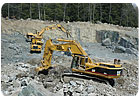
At the Fort Ann quarry site, all four varieties of granite are quarried - Summit, Van Tassell, Corinthian and American.
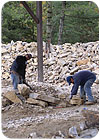
Hand splitting of stone is done in the timeless, but labor-intensive, method of using a hammer and chisel.
In 1990, the company introduced Great Meadow limestone®, meeting the demand for stone that provides an aged look for restoration, as well as a “fresh-split” look for new construction. A year later, it opened a quarry for American graniteTM, a brown material which also features an aged appearance as well as a fresh hand-split look.
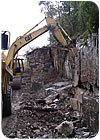
Among the different extraction methods, excavators from Caterpillar pull and dig the large pieces of stone from the ledge.
Today, the company produces four varieties of granite: American, Corinthian, Van Tassell® and Summit™, along with South Bay quartzite and Great Meadow limestone. Van Tassell, a granite with tones of buff, pink, blue/green and brown, was introduced in 2002, while Summit, a dense, dark blue-gray granite, featuring highlights of sage green, white and russet orange, was introduced in 2003.
Champlain Stone also recently expanded the Fort Ann location to include a facility for producing custom sawn and thin veneer products. This plant is run by Michael Morey’s son, Christian, who joined the company full time in 2003.
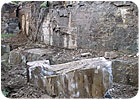
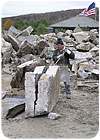
Workers use drills, feathers and wedges to split stone blocks.
Quarrying and splitting
During the quarrying process, stone is extracted from the topmost layers of the site by setting charges. Holes are drilled in the ledge, where explosive charges are placed and detonated. This way, stone is “bumped” away from the natural ledge rather than blown into small pieces. “We don’t blast often; only a few times a year,” Morey said, adding that the blasting is done by a subcontractor so they don’t have to keep explosives on the site.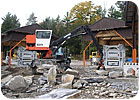
Hydraulic splitters - also referred to as “guillotines” - are also a key component of the process. The stone is loaded onto the conveyor by machine, and it is positioned by hand.
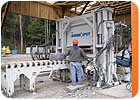
Splitting equipment includes Hydrasplit splitters from Park Industries as well as splitters from Cee Jay Tool Co. Any further trimming takes place by hand, and the stone is then placed in containers to be taken to the packaging area.
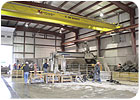
In January of 2005, Champlain Stone built a new plant at the Fort Ann quarry location for sawn products, including thin veneer as well as architectural work.
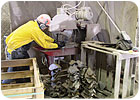
The company currently offers thin veneer in its American, Corinthian and Van Tassell granites as well as South Bay quartzite. Due to the skill required to produce corners, some of the workers in the plant specialize in this work.
The hand splitting of stone is done in the timeless, but labor-intensive, method of using a hammer and chisel. A sprinkler system is in place at the splitting bays to keep fugitive dust levels down and provide a cooler environment for the workers. Once material is split to specifications, it is loaded into containers and moved to the packaging area. Products that are split by hand include “mosaic” (irregularly shaped) veneer, flagging and wall stone.
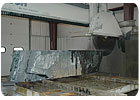
In addition to a series of smaller saws, the plant features a large-scale Predator saw from Park Industries, which can be equipped with blades up to 60 inches in diameter.
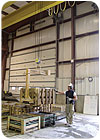
The plant also has a 10-ton Zinter overhead crane, which can maneuver pallets of stone around the space.
Moreover, the Fort Ann quarry site rises in elevation by 400 feet from the road. “When you consider that the benches of stone are 30 feet high, and you divide 400 by 30, that’s a lot of benches,” Morey said.
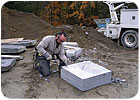
The company also processes stone for architectural projects. Here, Mac Morey processes edgework for a project at Fordham University in New York. After the edge is chipped by hand, it is thermal finished to achieve the desired look.
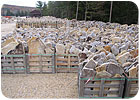
A vast inventory of flagstone products is maintained by the company.
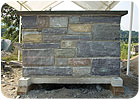
Building stone products include a range of wall veneer materials.
The company also strives to be environmentally conscious. “We want to work in harmony with the mountains,” Morey said, adding that the quarry sites are well camouflaged from any nearby roadways. “We’re our own best neighbor.”
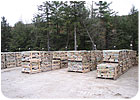
Due to the volume of work being produced, the shipping area must be extremely well organized, and bar codes are in place on the pallets to record the product, weight, date of packaging, and any special order information.
Custom sawing
In January of 2005, Champlain Stone built a new plant at the Fort Ann quarry location for sawn products, including thin veneer as well as architectural work. The company currently offers thin veneer in its American, Corinthian and Van Tassell granites as well as South Bay quartzite. These veneer products weigh 15 pounds or less per square foot, and they do not require a bearing shelf. Products include thin sawn “flats,” which are sold by the square foot, as well as thin sawn corner pieces, which are sold by the lineal foot. Due to the skill required to produce these pieces, some of the workers in the plant specialize in corner work. Additionally, hand select thin veneer is a split product, offering two usable faces.
Champlain Stone’s headquarters is located in an historic 19th century building in Warrensburg, NY, which is being extensively renovated with the company’s stone products.
In addition to a series of smaller saws, the plant features a large-scale Predator saw from Park Industries, which can be equipped with blades up to 60 inches in diameter. It also has a 10-ton Zinter overhead crane, which can maneuver pallets of stone around the space.
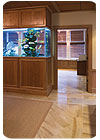
The inside of the office has also been expanded and renovated in a “Key West” theme, using rich woodwork as well as South Bay quartzite flooring.